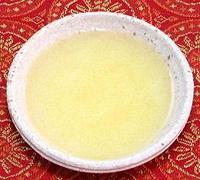
Ghee & Clarified Butter
Worldwide - [Asli Ghee (genuine ghee - not vegetable); Ghi (Bengal, Hindi, Gujarati, Urdu); Samna (Arabic); Roghan-e heivani (Persian); Erbo (Georgian)]
Effort:
Sched:
DoAhead:
**
1-1/2 hrs
Yes
|
Ghee & Clarified ButterWorldwide - [Asli Ghee (genuine ghee - not vegetable); Ghi (Bengal, Hindi, Gujarati, Urdu); Samna (Arabic); Roghan-e heivani (Persian); Erbo (Georgian)] | ||||
| Makes: Effort: Sched: DoAhead: |
1-1/3 cup ** 1-1/2 hrs Yes |
Ghee is much used in Africa, the Near and Middle East, Central and South Asia, and east to Malaysia and Indonesia. | |||
| Ghee can be stored for long periods without refrigeration, and also can be used for frying at elevated temperatures, up to 480°F/250°C. It has a buttery flavor that may be distinctly nutty, depending on how high the temperature is taken when it is made. The photo is of freshly made Ghee in a semi-solid slurry phase. | |||||
|
|
 Select a burner on your stove that can be very precisely controlled near
the bottom of its heat range, and preferably one with a heat spreader,
as in the photo, or use some other heat spreader on the burner.
Select a burner on your stove that can be very precisely controlled near
the bottom of its heat range, and preferably one with a heat spreader,
as in the photo, or use some other heat spreader on the burner.
Clarified Butter: Eventually the
bubbling will slow and be a lot more erratic, with small bursts of
bubbles rising to the surface. The temperature will start to rise above
212°F/100°C. When it gets quite erratic and up to around
240°F/115°C, you can call it Clarified Butter, give it
a final skim and decant it off the solids in the bottom. There will still
be some residual water in the butter, but Clarified Butter is usually
used right away, so this will not be a problem.
Caution: When spooning Ghee out
of the jar, it is important that the tools you use be totally dry. Any
moisture introduced could result in spoilage. The jar you store it in
must also have been totally dry before pouring the Ghee into it.
|